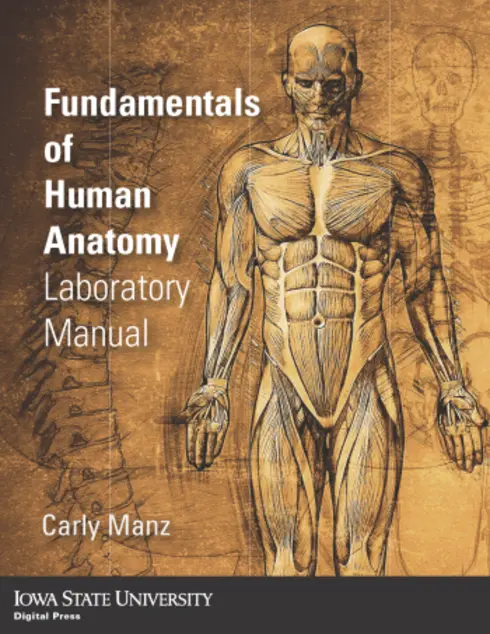
Fundamentals of Human Anatomy Laboratory Manual
![]()
![]()
![]()
![]()
![]()
Carly Manz, Iowa State University
Copyright Year:
Publisher: Iowa State University Digital Press
Language: English
Formats Available
Conditions of Use
![]() Attribution
Attribution
CC BY
Reviews
Reviewed by Deborah O'Dell, Professor, University of Mary Washington on 8/8/25
All body systems are covered in appropriate detail for an Undergraduate Human Anatomy classes. But, there is missing content, for example in the chapter on the integument, nails are not even mentioned as one of the accessory structures and glands... read more
![]()
![]()
![]()
![]()
![]()
Reviewed by Deborah O'Dell, Professor, University of Mary Washington on 8/8/25
Comprehensiveness
All body systems are covered in appropriate detail for an Undergraduate Human Anatomy classes. But, there is missing content, for example in the chapter on the integument, nails are not even mentioned as one of the accessory structures and glands which are typically discussed under tissues are not mentioned at all there with little structure discussed where they are mentioned.
Content Accuracy
Content is accurate, no errors found
Relevance/Longevity
The content is relevant and will continue to be relevant for many years. Although the cranial nerve memnomic is out dated with old names for some of the nerves.
Clarity
The writing is clear and easy to understand
Consistency
The book shows inconsistencies in coverage of individual structures and in language. For example in the description of the axial skeleton, the bones and features of the skull are shown and described in detail, with foramenia and features shown and labeled. However the mandible has a very short description, with little description or naming of relevant features (eg:condolyoid process) and no visual.
In the description of the skeleton of the upper appendage, the region known as the brachium is named as the "arm" and in the next paragraph, this area is referred to as the "upper arm".
In the description of the integument, the epidermal layers are discussed, but not the dermal layers.
In typical Anatomy texts there is generally a greater discussion of gland types and structure.
Modularity
The information is easily divided into smaller sections with subheadings.
Organization/Structure/Flow
The text is well organized in a clear fashion.
Interface
No interface issues noted
Grammatical Errors
No grammatical issues noted
Cultural Relevance
No thing noted.
CommentsThe book title says it is a lab manual, but there are no directions for student activities in this book. There is a separate document which is titled Lab activities" that must be downloaded which has lab activities. The lab document refers students to lecture slides for information and assumes faculty have TA's running the labs.
The introduction indicates that it includes cat dissections, and it refers to dissections at the end of the skeleton labs, but there are no illustrations or directions in subsequent labs. The book needs to decide whether it is a textbook or a lab book. It is lacking detail in structures as described, and lacking in directions and therefore isn't as useful as either type..
Reviewed by Amy Obringer, Professor of Biology, University of Saint Francis on 9/28/24
The Introduction states the Manual 'will provide the necessary support ...to use proper laboratory technique to dissect preserved animal specimens to explore anatomy." However, there were no figures, photos, or instructions regarding... read more
![]()
![]()
![]()
![]()
![]()
Reviewed by Amy Obringer, Professor of Biology, University of Saint Francis on 9/28/24
Comprehensiveness
The Introduction states the Manual 'will provide the necessary support ...to use proper laboratory technique to dissect preserved animal specimens to explore anatomy." However, there were no figures, photos, or instructions regarding dissection.
The book is thorough in its text, but lacking in dissection instruction.
Content Accuracy
Cranial nerve mnemonic is outdated and does not match the naming system.
Mnemonic uses "A" for vestibular cohlear (ie, old term of auditory) and "S" for (Spinal) Accessory.
Relevance/Longevity
All content is relevant and up to date
Clarity
Nicely written.
Figures are very good.
Consistency
Consistent organization
Modularity
good
Organization/Structure/Flow
Lymphatic and Respiratory are put together in a chapter.
I think it is more logical to combine Lymphatic with either blood or cardiovascular.
Interface
Free of interface issues
Grammatical Errors
no grammar issues
Cultural Relevance
one of the few lab books to include both light and dark-skinned figures
Table of Contents
- Introduction
- Lab 1: Introduction to Human Anatomy & Anatomical Terminology
- Lab 2: Cells and Tissues I
- Lab 3: Tissues II and Integumentary system
- Lab 4: Skeletal System I - Bone Tissue and Axial Skeleton
- Lab 5: Skeletal System II - Appendicular Skeleton and Joints
- Lab 6: Muscular System I - Muscle Tissue and Hindlimb Muscles
- Lab 7: Muscular System II - Forelimb and Axial Muscles
- Lab 8: Nervous system I - Nervous Tissue, Brain, Spinal Cord, and Cranial Nerves
- Lab 9: Nervous system II - Special Senses
- Lab 10: Cardiovascular System I - Blood and the Heart
- Lab 11: Cardiovascular system II - Blood Vessels
- Lab 12: Lymphatic & Respiratory systems
- Lab 13: Endocrine system & Digestive system
- Lab 14: Urinary system & Reproductive system
- Terms that may be asked on the BIOL 255L practical
- Acknowledgments
About the Book
This laboratory manual is meant to be used in a lab course that accompanies a college-level introductory human anatomy course. It covers the language of anatomy, cells and tissues, and the organ systems that comprise the human body. Multiple open textbooks were adapted to create this lab manual. Attribution for these sources are provided at the end of each chapter.
About the Contributors
Author
Carly Manz, Iowa State University
